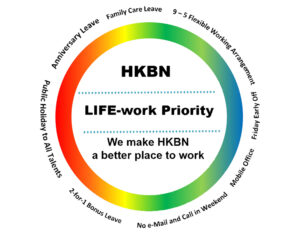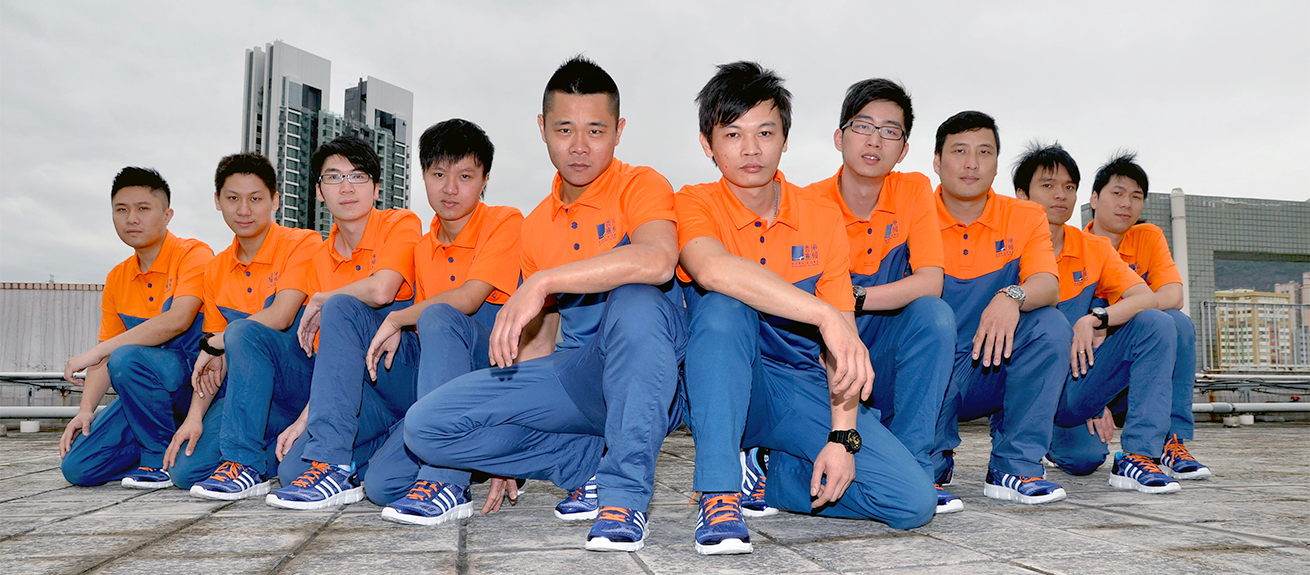At a glance
- HKBN wants to challenge the largest incumbent in Hong Kong’s highly competitive telecom industry.
- Snatching market share from the much larger entrenched incumbent is a formidable challenge.
- HKBN has followed a two-pronged approach by investing in a state-of-the-art fiber optic technology and in its talents.
- HKBN’s journey to become Hong Kong’s second largest broadband company offers insights into building sustainable competitive advantage by focusing on people.
Hong Kong owes much to its advanced telecommunications infrastructure for enabling its position as a leading business center in Asia Pacific. Its privately owned telecommunications industry offers a level playing field with no restriction on foreign investment. HKBN is the second largest provider of residential broadband services and the largest high-speed fiber broadband operator by number of subscriptions. In 2015, the company set itself a new target – to achieve the number one position by 2019.
One of the company’s core strengths is its employees. With competitors quickly catching up on the technology front, HKBN takes a holistic approach toward its Talents – investing in, enabling and empowering them – as the key source of competitive advantage. This has worked well given that HKBN has largely grown organically since its inception. However, it has started scaling up through the acquisition of complementary companies, and this raises several questions. What will be the impact of absorbing people from acquired companies into the HKBN fold? Can HKBN continue to rely on its talent strategy as a key driver of success? Can it sustain its entrepreneurial fast-paced performance-driven culture? What will characterize responsible leadership at HKBN going forward?
The broader issue
Today, technological innovations are increasingly altering industry structures and business models including cost positions, scale economies and power relations between manufacturers, intermediaries, buyers and sellers. In a high-tech industry such as telecommunications, the ability of a firm to identify and quickly harness technological advancement for creating value is crucial. We believe that there are two major issues facing tech firms. First, technology itself does not produce sustained performance advantage; at best, the advantage is transient. Further, the fast pace of technological change means that firms need to keep on investing in the latest innovations to stay ahead. Second, technology is prone to imitation. This makes it particularly difficult for firms to appropriate the value of their innovative efforts. Hence, the potential to turn technological competencies into competitive advantage remains short term. In our experience, it is a combination of technology with complementary human resources and business practices that enables a firm to gain superior performance advantages. HKBN is a case in point.
Leveraging technology
HKBN understood the potential of fiber optic technology way back in the early 2000s. It invested HKD4 million to build a large-capacity nationwide network (in partnership with Cisco) that would be resilient and scalable for the future. This was contrary to the perception of other industry players who did not believe in fiber and were busy cutting capital expenditure in the aftermath of the dotcom crash. Being a new entrant, HKBN knew that its service could not be marginally better; it had to be MUCH better in order to lure customers away from the entrenched incumbents. At a time when high-speed broadband was coveted and available only to upscale clients, HKBN made another counterintuitive move; it focused on the mass market, i.e. public housing estates. HKBN shocked the industry as it flipped around the value proposition and offered mass-market symmetric 10/100/1,000Mbps broadband services at highly competitive prices.
However, HKBN’s fiber optic infrastructure investment – a serious capital-intensive venture– meant that the company was cash flow negative for seven years. Despite that, early mover advantages enabled it to secure market share aggressively. By end-2015 HKBN’s fiber optic network covered over 2.2 million residential homes, representing approximately 81% of Hong Kong’s total residential units.
Pursuing a talent-first strategy
HKBN refers to all its employees as Talents and acknowledges that beyond technology what remains as its crucial differentiating factor are its Talents. It has invested in its people in three distinct ways:
- Aligning goals through co-ownership: HKBN has the highest employee interests among all telecom operators in Hong Kong. Co-ownership was a deliberate plan initiated by the top management team in 2012 when HKBN was sold to private equity fund CVC Capital Partners in a management buy-out (MBO). HKBN executives traded down the offered envy ratio and opened up the ownership of the company to 63 managers who invested their personal savings – the equivalent of two years’ salary – to buy an equity stake in HKBN. This was a serious commitment since they were buying into an unlisted entity. At IPO in 2015, the co-ownership scheme was further opened to supervisory grade employees and above, resulting in a strong alignment of interests and a renewed commitment to the future of HKBN. We believe that HKBN’s co- ownership model challenges the traditional ways of sharing the wealth generated by companies. Its primary focus is on the interests of a key stakeholder group – its Talents. HKBN believes that if a company outperforms, those who have contributed should be rewarded in line with the outcome.
- Embedding entrepreneurship through structures: Over the years, HKBN’s “mini-CEO” model worked well. The business was vertically structured in five geographic areas run by mini-CEOs who were fully empowered and responsible for the profit and loss and balance sheets for their areas. This ensured 1) decentralization of power, 2) simplification of processes and 3) agility. Furthermore, each area was benchmarked against the others to foster competition. Most importantly, it translated into succession planning. If the CEO were to leave, there existed a leadership bench strength of five people who could immediately step into his role. HKBN went a step further to instill an ethos of mini-entrepreneurship by removing traditional budget caps, moving the goalposts from meeting expectations to exceeding them.
- Building a high performance culture: What is unique about HKBN is that talent development is driven by one person who has dual responsibility as both Head of Talent engagement and CFO. For him, the Talent role takes precedence over the CFO role since he spends two-thirds of his time engaging with people and grooming the next generation of leaders. HKBN strives to attract top Talent and ensures that everybody stays on their toes by following three engagement pathways:
- Training: Talent management at HKBN is aimed at inspiration rather than motivation. Instead of the standard HR question on how to increase productivity by 20%, Talents are asked how HKBN could double their salary in three years– this means working smart rather than just working hard. The key is to re-evaluate individual strengths and weaknesses and close the learning gap by enhancing specific knowledge or skill sets in a given timeframe. Therefore, HKBN has formulated a number of talent development/engagement initiatives aimed at both job enlargement and job enrichment, at the individual, team and organizational levels.
- Termination Policy: HKBN is not a place for non-performers. The company institutes a 5% termination policy across all levels each year based on performance reviews. However, the policy has a couple of innovative differences: (1) It relates to 5% of the salary base rather than the number of employees. This means that if a senior manager earning HKD 100,000/ month is terminated, then the firing of five employees earning HKD 20,000/month can be avoided. (2) The 5% budget is not reduced. Instead it is used to reward the remaining 95%.
- LIFE-Work priority: HKBN does not promote work-life balance, it aggressively pursues LIFE-work priority; where LIFE comes first and is capitalized upon. It has established several first-of-its-kind practices in the local telecom industry such as flextime, flexi-location, no- email policy on weekends, 5 extra days of public holiday entitlement, 2-for-1 bonus leave scheme etc. The goal is to maintain a fine balance between building a dynamic high-performance organization culture and upholding LIFE-work priorities while driving aggressive growth. For HKBN, success goes beyond achieving financial and operational metrics to delivering its core purpose – “Make our Hong Kong a better place to live.”

Did it work?
Responsible leadership and robust talent management has been the cornerstone of HKBN. The company reached a life-stage milestone by becoming a listed company in 2015. Now it is answerable to shareholders and a larger group of stakeholders. With all the tangible and intangible elements in place, HKBN is confident of becoming the largest broadband provider in Hong Kong by 2019. It has secured a market leading position in the residential market and is now scaling up aggressively in the enterprise segment. Its first large-scale acquisition of the telecommunications and online marketing solutions of New World Telephone Holdings Ltd for HK$650 million (US$84 million) has enabled HKBN to leapfrog four to five years of organic growth and double its enterprise solutions business overnight. The co- ownership scheme has been extended and taken up by 54 newly acquired employees. As it pursues inorganic growth, it remains to be seen whether HKBN can continue to rely on its talent management practices as a sustainable driver of success.
Takeaways
Starting with only a vision and committed leadership, HKBN has grown from an entrepreneurial start-up to become a leading player in Hong Kong’s telecom industry. The following are some insights from HKBN’s journey:
- Be an outlier: Despite being a small player in a fiercely competitive industry, it is worthwhile daring to spearhead a series of innovative industry “firsts,” whether in terms of the products, processes or policies.
- Build causal ambiguity: It is essential to integrate technological resources, people capabilities and organizational practices and embed them at the core of the business so that the linkages are nearly impossible to comprehend. Such causal ambiguity provides a sustainable path to competitive advantage.
- Responsible leadership enables long-term viability: By aligning the talent agenda with the business strategy and prioritizing its people, a company can ensure that its talents will take care of the customers and this will in turn take care of the shareholders.






